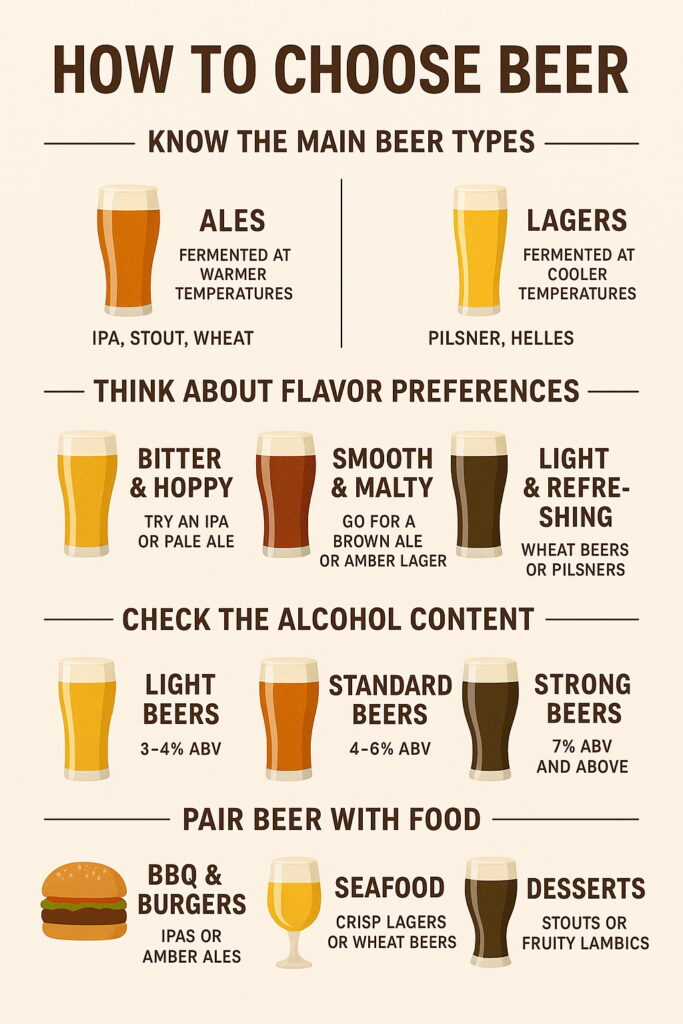Choosing a beer can be an exciting journey, and with so many options available, it’s easy to feel overwhelmed. Whether you’re a seasoned beer aficionado or a curious newcomer, here’s a guide to help you navigate the world of beer and find the perfect brew for any occasion.

1. Know the Basic Beer Families
Understanding the main categories of beer is a great starting point. The two biggest families are:
- Ales: These are brewed with top-fermenting yeast at warmer temperatures. They tend to have more complex, fruity, and robust flavors. Common ale styles include:
- IPA (India Pale Ale): Known for its hoppy, often bitter flavor and aromatic notes.
- Stout: Dark, rich, and often featuring notes of roasted coffee or chocolate (think Guinness).
- Porter: Similar to a stout, but often a bit lighter and with more caramel or nutty flavors.
- Wheat Beer (Hefeweizen): Light and refreshing, often with notes of banana and clove.
- Pale Ale: A balanced, less hoppy version of an IPA.
- Lagers: These are brewed with bottom-fermenting yeast at cooler temperatures. They are typically crisper, cleaner, and less complex in flavor. Common lager styles include:
- Pilsner: A classic, golden lager that is crisp, clean, and often has a slightly spicy or floral hop character.
- Light Lager: The most common style in the U.S., known for its very light body and mild flavor.
- Bock: A stronger, malty lager, often with a toasted or caramel flavor.
- Vienna Lager: Amber in color, with a smooth, malty flavor and a crisp finish.
2. Consider the Occasion and Season
The time of year and the setting can heavily influence your choice.
- Summer: Think light and refreshing. Pilsners, light lagers, and wheat beers are perfect for a hot day at a barbecue or a day at the beach.
- Winter: Opt for something more warming and substantial. Stouts, porters, and strong ales with rich, malty flavors are great for a cozy evening by the fire.
- Food Pairing: Beer, like wine, can be paired with food.
- Light beers (Pilsners, Lagers): Pair well with salads, seafood, and lighter dishes.
- Hoppy beers (IPAs): Cut through the richness of fried foods, spicy dishes, and burgers.
- Dark beers (Stouts, Porters): Complement rich desserts, roasted meats, and stews.
3. Read the Label (and the Menu)
Don’t just look at the brand name. Pay attention to the details on the bottle or on the menu.
- ABV (Alcohol by Volume): This tells you how strong the beer is. A higher ABV means more alcohol and often a fuller body and more intense flavor.
- IBU (International Bitterness Units): This measures the hoppiness of the beer. A higher IBU means it will be more bitter. If you don’t like bitter beers, look for a lower IBU.
- Description: Many craft beers have a flavor description on the label. Look for terms like “citrusy,” “roasted,” “malty,” or “hoppy” to get a better idea of what to expect.
4. Don’t Be Afraid to Experiment
The best way to find out what you like is to try new things.
- Order a Flight: If you’re at a brewery or a bar with a good selection, a beer flight is a great way to sample a few different styles in smaller portions.
- Ask for a Sample: Most places will be happy to let you have a small taste before you commit to a full pint.
- Talk to the Bartender: Don’t be shy! Bartenders and servers are often very knowledgeable about their beer selection and can give you great recommendations based on your preferences.
5. Start with What You Know
If you’re new to the world of beer, a good strategy is to start with a style you’re familiar with and then branch out from there.
- If you like light lagers: Try a Pilsner for a slightly more flavorful but still crisp experience.
- If you like fruity drinks: Explore a fruity sour or a wheat beer with notes of banana and clove.
- If you like coffee: A stout or a porter might be right up your alley.
Choosing a beer is all about personal preference. By understanding the basics, considering the context, and being open to new experiences, you’ll be well on your way to finding your next favorite brew. Cheers!
Leave a Reply
You must be logged in to post a comment.